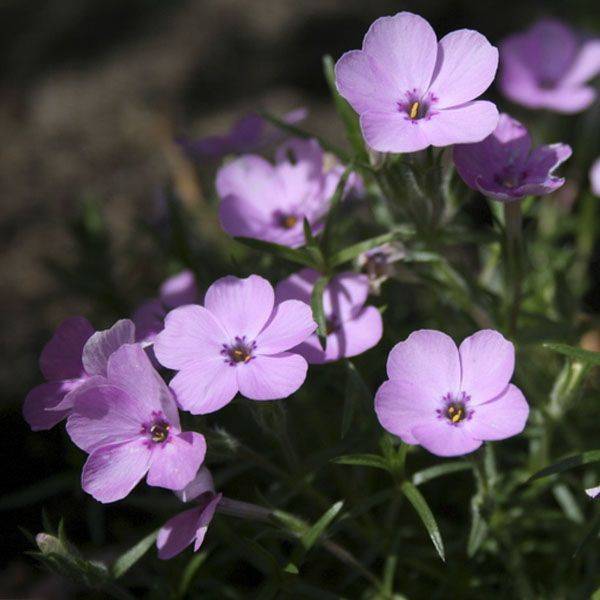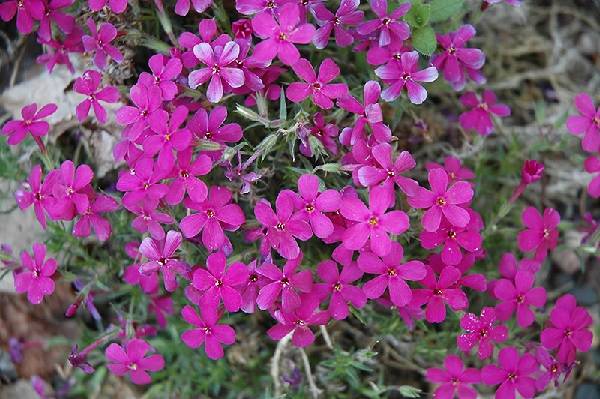Douglas phlox: groundcover
Content:
It is difficult to imagine a spring garden without blooming phlox, which delight the eye with bright pink or exquisite lilac shades. There are many types of these flowers, including a whole group of groundcover. The most popular of these is the Douglas phlox. Much less common are multi-flowered or forked phloxes, although they are also very beautiful. And among the creeping varieties, the styloid phlox, a "relative" of Douglas, is popular, which differs from the latter in the shape of the flowers.
The most common types in gardening
Almost all types of ground cover phlox in nature are found in high mountain areas or at least in hilly areas. Their homeland is North America, so they tolerate a dry, temperate climate well.
Ground cover phlox is a perennial shrub or herb, usually with needle-like leaves. It grows rapidly, as if spreading over the site.
Even after the phlox have faded, the curtain retains its decorative effect throughout the summer. Some varieties look very impressive during this period, thanks to their variegated leaves.
- Phlox Douglas White Admiral
This is a herbaceous perennial, which, when growing, forms "pillows" up to 20 cm in diameter. It blooms with small white flowers. Bushes reach a height of 5-10 cm.
- Phlox Douglas Red Admiral
This variety forms compact clumps with purple, less often bright lilac flowers. It has a very high density of buds, so that after they bloom, the shoots will be almost invisible.
- Phlox Douglas Lilac Cloud
This variety is distinguished by delicate lilac flowers, collected in inflorescences of 2-3 pieces. It is a perennial, and it winter well. Usually, when it grows, it forms something like a dense "rug" or "pillow" with a diameter of about 25-30 cm.
- Douglas phlox Phlox douglasii
Some budding gardeners consider Phlox Douglasii to be a separate cultivar. In fact - this is the Latin name, which is translated as "Douglas phlox". This plant also belongs to the ground cover.
The flower differs from the awl-shaped variety in its lower height - its bushes rarely grow above 10-12 cm. And its flowers are smaller, and the leaves are narrower, and it grows at a slower rate. But still, this variety is also capable of forming profusely blooming clumps.
There are many varieties and hybrids on the market today derived from Phlox Douglasii. One of the most interesting new products is Douglas Lachsjuvel's phlox. But in general, new varieties appear regularly.
- Phlox Douglas 'Crackerjack'
This variety is distinguished by purple-crimson star-shaped flowers. They reach a height of only 10 cm.
Using groundcover phlox in garden design
Many people think that phlox are somewhat old-fashioned plants. However, they look good in a modern garden too. They can be used in different ways in landscaping.
Most often they find a place for them in rocky gardens or in areas with difficult terrain. Ground covers on alpine hills or in rockeries look very beautiful.This type of plant can also be planted on the courtyard walls.
These are all classic options, but you can find more original ways to use this variety in landscape design. For example, an area overgrown with these flowers can be an alternative to a decorative lawn. It will liven up a flat terrain garden.
Finally, this variety will effectively emphasize the beauty of small architectural forms and silhouette sculptures.
Often in the literature you can find the term "curb phlox". But this is the name not only for Douglas phlox or related creeping varieties, but also for all other undersized varieties that can be used in other ways in design.
Reproduction of ground cover phlox
One of the advantages of this plant is that any methods of vegetative propagation are suitable for its settlement. The easiest cultivation option is to plant seeds, but can also be propagated by cuttings and rhizomes.
Growing from seeds
Seed propagation should not be difficult. Even novice gardeners can handle this. It is necessary to select a well-lit area, where in the second half of April the seeds are planted in open ground. In the future, the seedlings do not need special care.
It is recommended to grow through seedlings if phlox will then be planted in rock gardens, rockeries or in containers. In this case, they need to pick up loose, rocky soil.
Planting seeds is carried out without digging deep holes. In practice, they are simply spread over the surface so that later it turns out to be a solid carpet. You can even use different varieties on the same site, taking into account their characteristics. Sprinkle the seeds on top with a layer of mulch, which is a mixture of chopped grass, needles and sawdust. The bushes are strong enough to grow through such a barrier.
Watering should be regular, but not too abundant. And it is very important to prevent stagnation of water at the roots.
Reproduction of phlox by green cuttings
Theoretically, you can find containers with ready-made plant seedlings in stores today. However, many gardeners themselves can carry out cuttings.
This type of phlox reproduction is characterized by the fact that in this case, a branch with several pairs of leaves is used as a planting material. These cuttings can be cut in the summer - at any time.
 Phlox cuttings are ready for rooting
Phlox cuttings are ready for rooting
A suitable site is chosen for them, they are planted there - and the cuttings are given a slightly inclined position. It is important to provide them with regular watering. As a rule, they take two weeks to root.
However, you can wait for the rooting of cuttings in the water. In this case, the cut branches are not added dropwise, but placed in a glass of water, immersed in the liquid no more than 2-3 cm. The rooting process is slower, taking up to three weeks. In addition, it is considered more labor intensive as the plants will have to change the water every day.
Phlox care in autumn
Annual phloxes are practically not found in this group. It is mainly represented by evergreens that need to be properly prepared for wintering.
First of all, after the end of flowering, it is necessary to prune about a third of the height so that the "pillow" grows more actively, so that the bushes are denser, new branches would appear on them.
Curtains in the fall must be cleaned of falling leaves, because otherwise it will create favorable conditions for the development of diseases and the reproduction of pests. Cleaning can be done manually using a tool such as a fan rake, and after pruning, it is even better to do it with a garden vacuum cleaner.
Pest and disease control
While phlox plants are low maintenance and are generally considered hardy plants, diseases and pests can be problematic.
In particular, some gardeners are faced with ring spot. The difficulty is that in ordinary garden species of these flowers, the signs of the disease are more noticeable, and it is not immediately fashionable to notice spots of red color on small leaves of ground cover plants.
This disease is carried by nematodes, therefore, soil treatment with appropriate chemicals such as Carbation or Nemagon is an effective prevention of the disease.
 Phlox Douglas Lilac Cloud amazes with the tenderness of flowers
Phlox Douglas Lilac Cloud amazes with the tenderness of flowers
But such a problem as "rust" is more often faced by those who grow flowers of a burgundy or lilac shade. The most effective remedy is the treatment with Bordeaux liquid. As for powdery mildew, it is associated with an excess of nitrogen, which is why you do not need to overfeed the plant.
In general, the cultivation of ground cover phlox will not cause any special problems, but they will look very elegant, pleasing the eye almost all summer.
Video



















